
|
It brightened up to 8 mag from 2022 summer to 2023 spring. Now it is 10.2 mag (Apr. 23, Jose Guilherme de S. Aguiar). Fading slowly. In the Northern Hemisphere, it is not observable now, but it will appear in August. It locates somewhat low in the Southern Hemisphere. But it will become high in summer.
Date(TT) R.A. (2000) Decl. Delta r Elong. m1 Best Time(A, h)
May 6 4 48.75 -23 43.7 3.012 2.478 49 9.4 20:24 ( 74,-19)
May 13 4 59.31 -21 27.7 3.116 2.536 46 9.5 20:32 ( 79,-23)
|

|
Now it is 10.6 mag (Apr. 9, Ken-ichi Kadota). It stays 10 mag for a while. Now it is not observable. It will appear in June.
Date(TT) R.A. (2000) Decl. Delta r Elong. m1 Best Time(A, h)
May 6 2 37.71 25 25.1 3.217 2.228 9 10.0 3:30 (229, -9)
May 13 2 42.77 24 14.9 3.217 2.229 10 10.0 3:21 (233, -8)
|
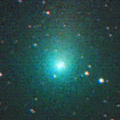
|
Now it is 10.6 mag (Apr. 27, Osamu Miyazaki). Fading gradually. In the Northern Hemisphere, it will be getting higher gradually. In the Southern Hemisphere, it is not observable now, but it will be observable soon.
Date(TT) R.A. (2000) Decl. Delta r Elong. m1 Best Time(A, h)
May 6 0 36.54 39 7.2 2.710 1.997 36 11.6 3:30 (235, 19)
May 13 0 42.83 38 26.1 2.724 2.042 39 11.8 3:21 (237, 21)
|

|
Now it is 12.1 mag (Apr. 27, Osamu Miyazaki). Fading slowly. It will be getting lower gradually after this, and it will be unobservable in July in the Northern Hemisphere, or in August in the Southern Hemisphere.
Date(TT) R.A. (2000) Decl. Delta r Elong. m1 Best Time(A, h)
May 6 10 49.55 -3 13.2 3.034 3.640 119 11.6 20:24 ( 12, 51)
May 13 10 41.68 -3 36.7 3.157 3.646 111 11.7 20:32 ( 28, 48)
|

|
Now it is 12.0 mag (Apr. 27, Ken-ichi Kadota). It will fade out rapidly after this. It will be fainter than 18 mag in July. In the Northern Hemisphere, it is not observable now, but it will appear in June. In the Southern Hemisphere, it will be getting higher gradually.
Date(TT) R.A. (2000) Decl. Delta r Elong. m1 Best Time(A, h)
May 6 0 5.78 -8 30.1 0.356 0.812 47 11.7 3:30 (279, -1)
May 13 0 27.61 -9 8.3 0.439 0.801 49 11.9 3:21 (279, -2)
|

|
It is expected to brighten up to 8 mag in July. Now it is 14.6 mag (Apr. 24, N. Paul, E. Cortes). It will brighten rapidly after this. In the Northern Hemisphere, it is not observable now, but it will appear in June. In the Southern Hemisphere, it will be getting higher gradually. At the high light, it will be observable in excellent condition in the Southern Hemisphere, but it will be very low in the Northern Hemisphere.
Date(TT) R.A. (2000) Decl. Delta r Elong. m1 Best Time(A, h)
May 6 0 41.30 -11 8.6 2.530 1.904 41 12.3 3:30 (276,-10)
May 13 0 42.73 -11 33.0 2.358 1.847 48 12.0 3:21 (279, -7)
|

|
It approached to Earth down to 0.29 a.u. in early February, and it brightened up to 4.5 mag (Feb. 1, Juan Jose Gonzalez). Now it is 11.6 mag (Apr. 23, Jose Guilherme de S. Aguiar). Fading gradually. In the Northern Hemisphere, it is not observable now. It locates somewhat low in the Southern Hemisphere. But it will become high in summer.
Date(TT) R.A. (2000) Decl. Delta r Elong. m1 Best Time(A, h)
May 6 5 18.58 -12 8.0 2.607 2.048 46 12.2 20:24 ( 80, -7)
May 13 5 24.35 -13 0.3 2.732 2.128 44 12.5 20:32 ( 83,-14)
|

|
Now it is 12.2 mag (Apr. 30, Marco Goiato). Fading slowly. In the Northern Hemisphere, it is not observable now. In the Southern Hemisphere, it stays observable in good condition. It was expected to brighten up to 10 mag from spring to summer. However, it is fainter than originally expected.
Date(TT) R.A. (2000) Decl. Delta r Elong. m1 Best Time(A, h)
May 6 20 47.00 -58 48.3 2.665 3.073 104 12.3 3:30 (342, -8)
May 13 20 53.73 -62 22.3 2.596 3.074 108 12.3 3:21 (345,-11)
|
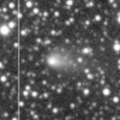
|
It brightened very rapidly as expected. Now it is 12.7 mag (Apr. 24, Ken-ichi Kadota). Fading slowly. It stays observable in good condition.
Date(TT) R.A. (2000) Decl. Delta r Elong. m1 Best Time(A, h)
May 6 19 42.32 -14 0.4 1.406 1.988 109 12.7 3:30 (335, 37)
May 13 19 49.05 -12 22.1 1.343 1.987 114 12.6 3:21 (338, 40)
|

|
Now it is 13.3 mag (Apr. 24, Osamu Miyazaki). It will fade out rapidly after this. It stays observable in good condition.
Date(TT) R.A. (2000) Decl. Delta r Elong. m1 Best Time(A, h)
May 6 17 49.79 -18 20.5 1.231 2.086 137 12.6 2:57 ( 0, 37)
May 13 17 46.23 -18 16.5 1.219 2.125 144 12.7 2:26 ( 0, 37)
|

|
It brightened up to 8.3 mag in last winter (Jan. 6, 2022, Toshiyuki Takahashi). Now it is 12.8 mag (Apr. 23, Jose Guilherme de S. Aguiar). Fading slowly. In the Northern Hemisphere, it will be unobservable in June. In the Southern Hemisphere, it stays observable in good condition.
Date(TT) R.A. (2000) Decl. Delta r Elong. m1 Best Time(A, h)
May 6 9 4.65 -31 19.7 5.209 5.499 101 12.8 20:24 ( 30, 16)
May 13 9 6.86 -30 57.0 5.326 5.543 97 12.9 20:32 ( 36, 13)
|
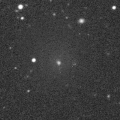
|
It has large but very diffuse coma. It seems to brighten up to 10.5 mag in July. Now it is 12.9 mag (Apr. 21, Thomas Lehmann). Brightening gradually. In the Northern Hemisphere, it stays observable in good condition. In the Southern Hemisphere, it is not observable now, but it will appear in August.
Date(TT) R.A. (2000) Decl. Delta r Elong. m1 Best Time(A, h)
May 6 12 13.14 57 12.2 0.767 1.365 99 13.3 21:17 (180, 68)
May 13 12 10.49 60 50.2 0.769 1.297 92 12.9 20:47 (180, 64)
|
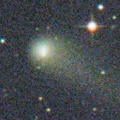
|
It brightened up to 11.1 mag in early 2022 (Mar. 31, 2022, F. Kugel, J.-G. Bosch, J. Nicolas). Now it is 13.0 mag (Apr. 28, Osamu Miyazaki). Fading slowly. It stays observable in good condition.
Date(TT) R.A. (2000) Decl. Delta r Elong. m1 Best Time(A, h)
May 6 15 32.04 18 47.1 4.190 5.036 143 13.2 0:40 ( 0, 74)
May 13 15 28.86 19 38.1 4.231 5.066 142 13.3 0:09 ( 0, 75)
|

|
Rob Matson discovered it as a new comet from SWAN images between Apr. 5 and 15. It was revealed to be an asteroid which has been observed also in 2012 and 2018. It approached to Sun down to 0.5 a.u. on Mar. 29. Now it is 13.6 mag (Apr. 20, Michael Jager). It will fade out rapidly after this. It will be fainter than 18 mag in July. In the Northern Hemisphere, it is not observable now, but it will appear in June. In the Southern Hemisphere, it will be getting higher gradually.
Date(TT) R.A. (2000) Decl. Delta r Elong. m1 Best Time(A, h)
May 6 3 15.71 -47 58.4 0.421 0.911 64 13.7 20:24 ( 53,-45)
May 13 3 14.38 -60 53.8 0.396 1.013 79 14.0 3:21 (324,-48)
|
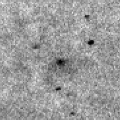
|
Now it is 13.0 mag (Apr. 25, Jose Guilherme de S. Aguiar). Fading slowly. It locates somewhat low in the Northern Hemisphere. But it will become high in summer. In the Southern Hemisphere, it stays observable in good condition.
Date(TT) R.A. (2000) Decl. Delta r Elong. m1 Best Time(A, h)
May 6 23 37.96 -10 49.8 2.248 1.857 54 13.7 3:30 (285, 3)
May 13 23 51.95 -9 35.8 2.225 1.889 57 13.8 3:21 (285, 5)
|
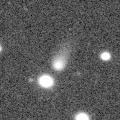
|
It is expected to brighten up to 7 mag in early 2024. Now it is 14.1 mag (Apr. 19, ATLAS South Africa). Brightening gradually. In the Northern Hemisphere, it is not observable now. In the Southern Hemisphere, it will be getting lower gradually. But it will be getting higher again after July.
Date(TT) R.A. (2000) Decl. Delta r Elong. m1 Best Time(A, h)
May 6 5 48.22 -25 53.0 4.264 3.869 60 14.0 20:24 ( 65, -9)
May 13 5 55.49 -25 16.6 4.234 3.798 58 13.9 20:32 ( 69,-14)
|

|
Now it is 13.7 mag (Apr. 19, W. Pei). It stays 14 mag for a while. It will be unobservable in June. But it will be observable again in August in the Northern Hemisphere, or in September in the Southern Hemisphere.
Date(TT) R.A. (2000) Decl. Delta r Elong. m1 Best Time(A, h)
May 6 6 39.63 26 54.8 6.634 6.096 54 14.0 20:24 (103, 31)
May 13 6 44.26 26 43.7 6.723 6.098 48 14.0 20:32 (106, 25)
|
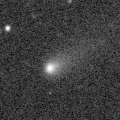
|
Now it is 13.9 mag (Apr. 27, Ken-ichi Kadota). Fading gradually. In the Northern Hemisphere, it will be unobservable in September. In the Southern Hemisphere, it stays observable in good condition.
Date(TT) R.A. (2000) Decl. Delta r Elong. m1 Best Time(A, h)
May 6 13 46.15 -30 57.5 1.388 2.359 159 14.0 22:50 ( 0, 24)
May 13 13 38.41 -31 28.4 1.413 2.364 154 14.1 22:15 ( 0, 23)
|

|
The brightness evolution is slower than originally predicted. Now it is 14.9 mag (May 2, ATLAS Chile). It stays 14 mag for a while. In the Northern Hemisphere, it is not observable now. It locates somewhat low in the Southern Hemisphere. But it will become high in winter.
Date(TT) R.A. (2000) Decl. Delta r Elong. m1 Best Time(A, h)
May 6 4 52.91 -25 10.7 2.508 2.033 51 14.0 20:24 ( 72,-19)
May 13 5 7.15 -26 28.2 2.497 2.038 52 14.0 20:32 ( 73,-24)
|
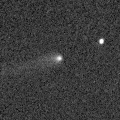
|
Now it is 14.9 mag (Mar. 19, Masayoshi Yoshimi). It stays 14 mag for a while. Now it is not observable. It will appear soon in the Southern Hemisphere, or in June in the Northern Hemisphere.
Date(TT) R.A. (2000) Decl. Delta r Elong. m1 Best Time(A, h)
May 6 2 38.96 0 10.6 4.195 3.240 16 14.7 3:30 (249,-27)
May 13 2 40.20 0 59.6 4.172 3.237 19 14.7 3:21 (251,-23)
|

|
It will brighten rapidly up to 13.5 mag in summer. Now it is 15.7 mag (Apr. 24, N. Paul, E. Cortes). Brightening slowly. In the Northern Hemisphere, it is not observable now, but it will appear in June. In the Southern Hemisphere, it stays observable in good condition.
Date(TT) R.A. (2000) Decl. Delta r Elong. m1 Best Time(A, h)
May 6 0 23.19 -19 13.2 2.298 1.832 50 15.0 3:30 (286,-11)
May 13 0 35.38 -16 15.5 2.232 1.807 52 14.8 3:21 (284, -8)
|

|
Now it is 16.1 mag (May 1, J. L. Virlichie, P. Traverse, H. Roy, G. Houdin). It stays 15 mag for a while. It stays observable in good condition.
Date(TT) R.A. (2000) Decl. Delta r Elong. m1 Best Time(A, h)
May 6 18 35.50 -17 19.5 2.277 2.986 126 15.2 3:30 (356, 38)
May 13 18 35.84 -18 2.4 2.194 2.975 132 15.0 3:16 ( 0, 37)
|
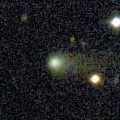
|
Now it is 14.8 mag (Apr. 19, W. Pei). Fading slowly. In the Northern Hemisphere, it will be getting lower gradually. In the Southern Hemisphere, it will be unobservable in August.
Date(TT) R.A. (2000) Decl. Delta r Elong. m1 Best Time(A, h)
May 6 9 43.03 28 26.9 3.253 3.464 93 15.1 20:24 ( 78, 69)
May 13 9 49.14 27 59.9 3.359 3.480 88 15.2 20:32 ( 84, 62)
|

|
It is expected to brighten up to 11 mag in July. Now it is 19.8 mag (May 3, iTelescope Deep Sky Chile, Rio Hurtado). Brightening rapidly. It stays extremely low in the Northern Hemisphere. But it will become high in autumn. It locates somewhat low in the Southern Hemisphere.
Date(TT) R.A. (2000) Decl. Delta r Elong. m1 Best Time(A, h)
May 6 23 32.54 8 1.9 1.764 1.336 48 15.8 3:30 (271, 15)
May 13 23 59.02 10 28.3 1.694 1.272 48 15.2 3:21 (267, 15)
|

|
Now it is 15.7 mag (May 3, ATLAS-HKO, Haleakala). It stays 15 mag for a while. It stays observable in good condition. It is expected to brighten up to 12.5 mag in 2024 spring. At the high light, it will be observable in excellent condition in the Southern Hemisphere, but it will be low in the Northern Hemisphere.
Date(TT) R.A. (2000) Decl. Delta r Elong. m1 Best Time(A, h)
May 6 18 4.41 21 57.9 3.540 4.122 118 15.4 3:12 ( 0, 77)
May 13 17 54.57 22 29.3 3.421 4.073 123 15.2 2:35 ( 0, 77)
|
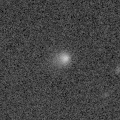
|
Now it is 15.2 mag (Apr. 19, Chris Wyatt). It stays 15 mag for a while. It will be getting lower gradually after this, and it will be unobservable in June in the Northern Hemisphere, or in July in the Southern Hemisphere. It is expected to brighten up to 12 mag from 2024 to 2025.
Date(TT) R.A. (2000) Decl. Delta r Elong. m1 Best Time(A, h)
May 6 8 56.04 -4 23.3 5.488 5.627 92 15.3 20:24 ( 48, 38)
May 13 8 55.05 -3 26.0 5.566 5.585 85 15.3 20:32 ( 57, 33)
|
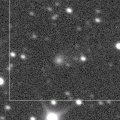
|
It will brighten up to 14 mag from 2024 to 2025. Now it is 15.2 mag (Apr. 17, Ken-ichi Kadota). It stays 15 mag for a while. In the Northern Hemisphere, it will be unobservable in June. In the Southern Hemisphere, it stays observable in good condition.
Date(TT) R.A. (2000) Decl. Delta r Elong. m1 Best Time(A, h)
May 6 8 50.61 -31 30.2 5.984 6.215 98 15.3 20:24 ( 32, 15)
May 13 8 53.67 -30 46.4 6.025 6.185 94 15.3 20:32 ( 39, 12)
|

|
Brightened rapidly. Now it is 14.5 mag (Apr. 27, Masayoshi Yoshimi). It will fade out rapidly after this. It will be fainter than 18 mag in July. It stays observable in good condition.
Date(TT) R.A. (2000) Decl. Delta r Elong. m1 Best Time(A, h)
May 6 12 32.53 -17 52.3 0.961 1.890 147 15.3 21:37 ( 0, 37)
May 13 12 40.42 -13 16.8 1.026 1.926 142 15.5 21:18 ( 0, 42)
|

|
It will brighten up to 13 mag in summer. Now it is 16.3 mag (Apr. 9, Ken-ichi Kadota). Brightening gradually. In the Northern Hemisphere, it will be getting higher gradually. In the Southern Hemisphere, it is not observable now, but it will appear in August.
Date(TT) R.A. (2000) Decl. Delta r Elong. m1 Best Time(A, h)
May 6 2 6.76 63 20.0 2.048 1.557 47 15.5 3:30 (205, 21)
May 13 2 4.05 63 9.1 2.019 1.516 46 15.3 3:21 (207, 22)
|

|
It brightened up to 13.4 mag in last summer (July 7, Giuseppe Pappa). Now it is 14.8 mag (Apr. 27, Toshiyuki Takahashi). Fading slowly. In the Northern Hemisphere, it stays observable in good condition. It locates somewhat low in the Southern Hemisphere.
Date(TT) R.A. (2000) Decl. Delta r Elong. m1 Best Time(A, h)
May 6 17 25.69 24 23.2 3.063 3.726 124 15.4 2:33 ( 0, 79)
May 13 17 14.73 26 37.6 3.073 3.766 126 15.5 1:55 ( 0, 82)
|

|
Now it is 16.4 mag (Apr. 28, B. Lutkenhoner, N. Paul, E. Cortes). It stays 15 mag for a while. It locates somewhat low in the Northern Hemisphere. But it will become high in summer. In the Southern Hemisphere, it stays observable in good condition.
Date(TT) R.A. (2000) Decl. Delta r Elong. m1 Best Time(A, h)
May 6 23 50.16 -9 4.3 3.908 3.368 51 15.5 3:30 (282, 1)
May 13 23 57.87 -8 22.1 3.844 3.382 55 15.4 3:21 (283, 4)
|
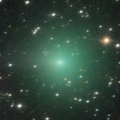
|
It brightened up to 9.7 mag in autumn (Oct. 23, Marco Goiato). Now it is 16.7 mag (May 2, ATLAS South Africa). It will fade out rapidly after this. It will be fainter than 18 mag in June. It locates somewhat low in the Northern Hemisphere. In the Southern Hemisphere, it stays observable in good condition.
Date(TT) R.A. (2000) Decl. Delta r Elong. m1 Best Time(A, h)
May 6 15 42.83 -42 18.4 1.589 2.522 151 16.1 0:53 ( 0, 13)
May 13 15 8.07 -39 27.5 1.616 2.584 158 16.4 23:42 ( 0, 16)
|
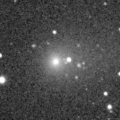
|
It brightened up to 12.4 mag in winter (Feb. 10, Taras Prystavski). Now it is 15.8 mag (Apr. 20, Ken-ichi Kadota). Fading gradually. It will be fainter than 18 mag in July. In the Northern Hemisphere, it will be getting lower gradually. In the Southern Hemisphere, it stays observable in good condition.
Date(TT) R.A. (2000) Decl. Delta r Elong. m1 Best Time(A, h)
May 6 9 24.62 19 44.4 1.982 2.261 92 16.1 20:24 ( 66, 61)
May 13 9 34.80 19 10.0 2.091 2.292 88 16.3 20:32 ( 72, 55)
|

|
Now it is 16.5 mag (Apr. 10, Michael Jager). It stays 16 mag for a while. In the Northern Hemisphere, it will be unobservable in June. In the Southern Hemisphere, it will be getting lower gradually. But it will be getting higher again after August.
Date(TT) R.A. (2000) Decl. Delta r Elong. m1 Best Time(A, h)
May 6 8 19.19 -9 0.5 3.875 3.923 85 16.4 20:24 ( 53, 29)
May 13 8 18.92 -9 24.4 3.961 3.903 79 16.4 20:32 ( 60, 22)
|
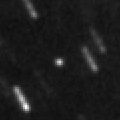
|
It will approach to Sun down to 0.4 a.u. in late September in 2024, and it is expected to brighten up to 0 mag. Now it is 16.6 mag (Apr. 27, Ken-ichi Kadota). It stays 16 mag for a while. It stays observable in good condition. At the high light, in the Northern Hemisphere, it will be observable in good condition after the perihelion passage. In the Southern Hemisphere, it will be observable in the low sky before and after the perihelion passage.
Date(TT) R.A. (2000) Decl. Delta r Elong. m1 Best Time(A, h)
May 6 14 47.84 2 24.8 5.700 6.663 161 16.5 23:51 ( 0, 57)
May 13 14 42.62 2 42.3 5.654 6.599 157 16.5 23:19 ( 0, 58)
|

|
It continued brightening even after the perihelion passage, and brightened up to 13.9 mag in winter (Jan. 20, Hidenori Nohara). Now it is 16.9 mag (Apr. 20, Ken-ichi Kadota). Fading slowly. It will be fainter than 18 mag in July. In the Northern Hemisphere, it will be getting lower gradually after this, and it will be unobservable in July. It locates somewhat low in the Southern Hemisphere.
Date(TT) R.A. (2000) Decl. Delta r Elong. m1 Best Time(A, h)
May 6 8 16.69 24 5.8 2.996 2.922 76 16.6 20:24 ( 87, 49)
May 13 8 25.44 23 38.6 3.110 2.947 71 16.7 20:32 ( 90, 44)
|

|
Now it is 17.2 mag (May 3, ATLAS-HKO, Haleakala). Fading slowly. It will be fainter than 18 mag in August. In the Northern Hemisphere, it will be getting lower gradually. In the Southern Hemisphere, it stays observable in good condition.
Date(TT) R.A. (2000) Decl. Delta r Elong. m1 Best Time(A, h)
May 6 9 1.96 23 53.6 2.057 2.230 86 16.8 20:24 ( 78, 58)
May 13 9 12.38 22 55.3 2.131 2.228 81 16.8 20:32 ( 82, 53)
|

|
Very far object. Now it is 17.0 mag (May 2, ATLAS South Africa). It stays 17 mag for a while. In the Northern Hemisphere, it is not observable now. In the Southern Hemisphere, it stays observable in good condition.
Date(TT) R.A. (2000) Decl. Delta r Elong. m1 Best Time(A, h)
May 6 5 3.27 -68 8.9 10.354 10.365 87 16.8 20:24 ( 27,-34)
May 13 5 6.23 -67 49.1 10.342 10.361 88 16.8 20:32 ( 27,-37)
|

|
Now it is 17.0 mag (Apr. 15, J. Linder). It stays 17 mag for a while. In the Northern Hemisphere, it stays observable in good condition. In the Southern Hemisphere, it is not observable now, but it will be observable soon.
Date(TT) R.A. (2000) Decl. Delta r Elong. m1 Best Time(A, h)
May 6 13 0.13 56 16.9 2.632 3.036 103 16.9 22:04 (180, 69)
May 13 12 59.63 55 53.2 2.664 3.016 100 16.9 21:36 (180, 69)
|
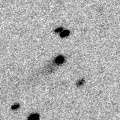
|
Now it is 17.0 mag (Apr. 11, Michael Jager). It stays 17 mag for a while. In the Northern Hemisphere, it stays observable in good condition. In the Southern Hemisphere, it will be getting lower gradually after this, and it will be unobservable in September.
Date(TT) R.A. (2000) Decl. Delta r Elong. m1 Best Time(A, h)
May 6 12 36.71 13 33.3 8.233 8.981 135 16.9 21:41 ( 0, 68)
May 13 12 32.88 13 50.3 8.326 8.989 128 16.9 21:09 ( 0, 69)
|

|
It brightened up to 13.6 mag in 2021 (June 17, 2021, R. Carstens). Now it is 16.9 mag (May 2, ATLAS South Africa). It stays 17 mag for a while. In the Northern Hemisphere, it will never be observable after this. In the Southern Hemisphere, it stays observable in good condition.
Date(TT) R.A. (2000) Decl. Delta r Elong. m1 Best Time(A, h)
May 6 11 55.75 -72 8.5 5.930 6.475 118 17.0 20:59 ( 0,-17)
May 13 11 40.57 -71 12.2 5.967 6.508 118 17.0 20:32 ( 1,-16)
|

|
The ATLAS search program detected its cometary activity in April. Now it is 16.7 mag (May 3, ATLAS Chile). It stays 17 mag for a while. It locates somewhat low in the Northern Hemisphere. In the Southern Hemisphere, it stays observable in good condition.
Date(TT) R.A. (2000) Decl. Delta r Elong. m1 Best Time(A, h)
May 6 22 33.09 -25 36.2 2.763 2.688 75 17.1 3:30 (306, 5)
May 13 22 44.77 -25 12.1 2.691 2.691 79 17.0 3:21 (307, 7)
|

|
It brightened up to 12.7 mag in last year (Feb. 27, 2022, Jose Guilherme de S. Aguiar). Now it is 17.7 mag (May 2, ATLAS South Africa). Fading slowly. It will be fainter than 18 mag in August. It locates somewhat low in the Northern Hemisphere. In the Southern Hemisphere, it stays observable in good condition.
Date(TT) R.A. (2000) Decl. Delta r Elong. m1 Best Time(A, h)
May 6 20 4.94 -24 36.5 2.454 2.908 106 17.0 3:30 (334, 26)
May 13 20 7.18 -24 40.6 2.389 2.934 112 17.1 3:21 (338, 27)
|

|
It returns for the first time in 70 years. It will brighten up to 4.5 mag in 2024 spring. Now it is 17.6 mag (Apr. 20, Ken-ichi Kadota). Brightening gradually. In the Northern Hemisphere, it stays observable in good condition. In the Southern Hemisphere, it will be unobservable in July.
Date(TT) R.A. (2000) Decl. Delta r Elong. m1 Best Time(A, h)
May 6 19 36.11 43 24.7 4.489 4.628 91 17.2 3:30 (234, 74)
May 13 19 34.70 45 3.8 4.379 4.562 93 17.1 3:21 (221, 76)
|
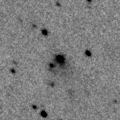
|
It approached to Sun down to 0.1 a.u. on Jan. 31. It was bright as 7.0-7.5 mag in early February (Feb. 5, Michael Jager). Now it is 16.0 mag (Apr. 24, Ken-ichi Kadota). It will fade out rapidly after this. It will be fainter than 18 mag in June. It stays observable in good condition.
Date(TT) R.A. (2000) Decl. Delta r Elong. m1 Best Time(A, h)
May 6 19 55.90 -11 13.4 1.470 1.998 105 17.1 3:30 (330, 39)
May 13 19 44.92 -12 6.8 1.448 2.091 115 17.3 3:21 (339, 41)
|

|
It brightened up to 9.3 mag in early summer in 2022 (June 5, Chris Wyatt). Now it is 16.8 mag (Apr. 17, Masayoshi Yoshimi). Fading slowly. It will be fainter than 18 mag in June. In the Northern Hemisphere, it will be unobservable soon. In the Southern Hemisphere, it will be getting lower gradually.
Date(TT) R.A. (2000) Decl. Delta r Elong. m1 Best Time(A, h)
May 6 6 51.17 -4 29.2 4.535 4.177 63 17.2 20:24 ( 73, 16)
May 13 6 54.58 -3 25.6 4.693 4.240 57 17.3 20:32 ( 78, 10)
|
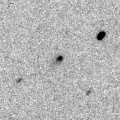
|
Now it is 17.3 mag (Apr. 17, Masayoshi Yoshimi). It stays 18 mag for a while. In the Northern Hemisphere, it will be getting lower gradually. It locates somewhat low in the Southern Hemisphere.
Date(TT) R.A. (2000) Decl. Delta r Elong. m1 Best Time(A, h)
May 6 9 33.83 33 17.7 2.330 2.538 89 17.2 20:24 ( 93, 68)
May 13 9 41.67 32 12.8 2.403 2.531 85 17.2 20:32 ( 93, 62)
|
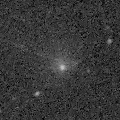
|
Very large comet. It is expected to brighten up to 14 mag in 2031. Now it is 16.7 mag (Apr. 14, Thomas Lehmann). It stays 17 mag for a while. In the Northern Hemisphere, it is not observable now. In the Southern Hemisphere, it will be getting higher gradually. In the Northern Hemisphere, it is not observable until 2030.
Date(TT) R.A. (2000) Decl. Delta r Elong. m1 Best Time(A, h)
May 6 2 56.88 -57 16.0 17.959 17.700 73 17.3 20:24 ( 41,-48)
May 13 3 0.05 -57 19.0 17.900 17.675 75 17.2 3:21 (319,-47)
|

|
It brightened up to 9.6 mag in late January (Jan. 25, Toshihiko Ikemura, Hirohisa Sato). Now it is 14.5 mag (Apr. 12, Thomas Lehmann). Fading rapidly. It will be fainter than 18 mag soon. It locates somewhat low in the Northern Hemisphere. In the Southern Hemisphere, it stays observable in good condition.
Date(TT) R.A. (2000) Decl. Delta r Elong. m1 Best Time(A, h)
May 6 7 49.75 -10 4.8 2.008 2.063 78 17.4 20:24 ( 58, 23)
May 13 8 0.83 -11 19.3 2.141 2.134 75 17.9 20:32 ( 61, 18)
|

|
It is expected to brighten up to 7.5 mag in October, and it will be observable in excellent condition. Now it is 19.0 mag (Apr. 28, J. L. Virlichie, P. Traverse, H. Roy, G. Houdin). It will brighten rapidly after this. It stays observable in good condition. In the Southern Hemisphere, it becomes low temporarily around the high light.
Date(TT) R.A. (2000) Decl. Delta r Elong. m1 Best Time(A, h)
May 6 21 25.22 -0 36.9 2.103 2.197 81 17.8 3:30 (300, 35)
May 13 21 36.04 1 0.8 1.969 2.136 85 17.4 3:21 (300, 37)
|
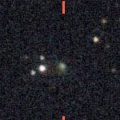
|
It brightened rapidly up to 15.8 mag (Mar. 19, Toshihiko Ikemura, Hirohisa Sato). Now it is 16.4 mag (Apr. 10, Michael Jager). It will fade out rapidly after this. It will be fainter than 18 mag soon. In the Northern Hemisphere, it will be getting lower gradually. It locates somewhat low in the Southern Hemisphere.
Date(TT) R.A. (2000) Decl. Delta r Elong. m1 Best Time(A, h)
May 6 7 21.90 17 14.6 2.134 1.933 64 17.4 20:24 ( 87, 35)
May 13 7 25.87 14 18.3 2.269 1.962 59 17.7 20:32 ( 89, 27)
|

|
It stays 17 mag for a while. In the Northern Hemisphere, it will be getting higher gradually. In the Southern Hemisphere, it stays observable in good condition.
Date(TT) R.A. (2000) Decl. Delta r Elong. m1 Best Time(A, h)
May 6 22 21.87 -9 12.6 3.226 3.050 71 17.6 3:30 (296, 18)
May 13 22 29.71 -8 51.1 3.132 3.047 75 17.5 3:21 (298, 21)
|
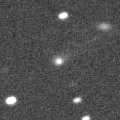
|
It brightened up to 15.9 mag in 2022 spring (May 5, Toshiyuki Takahashi). Now it is 16.9 mag (Apr. 27, Yasukazu Ikari). It stays 18 mag for a while. It stays observable in good condition.
Date(TT) R.A. (2000) Decl. Delta r Elong. m1 Best Time(A, h)
May 6 16 22.08 -24 40.3 3.981 4.924 156 17.5 1:30 ( 0, 30)
May 13 16 18.63 -24 37.2 3.951 4.932 164 17.5 0:59 ( 0, 30)
|

|
It has not been observed yet in this apparition. Now it is mag ( , ). Brightening slowly. It stays observable in good condition.
Date(TT) R.A. (2000) Decl. Delta r Elong. m1 Best Time(A, h)
May 6 18 29.73 -15 24.7 2.225 2.947 127 17.7 3:30 (358, 40)
May 13 18 29.48 -14 47.8 2.132 2.924 133 17.6 3:09 ( 0, 40)
|

|
Now it is 17.4 mag (Apr. 22, ATLAS-HKO, Haleakala). It stays 18 mag for a while. In the Northern Hemisphere, it stays observable in good condition. In the Southern Hemisphere, it will never be observable after this.
Date(TT) R.A. (2000) Decl. Delta r Elong. m1 Best Time(A, h)
May 6 17 56.74 78 20.1 10.007 9.914 81 17.6 3:02 (180, 47)
May 13 17 42.82 79 0.0 10.044 9.932 80 17.7 2:21 (180, 46)
|
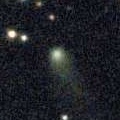
|
Now it is 17.9 mag (Apr. 8, Mt. Lemmon Survey). It stays 18 mag for a while. In the Northern Hemisphere, it stays observable in good condition. In the Southern Hemisphere, it will never be observable after this.
Date(TT) R.A. (2000) Decl. Delta r Elong. m1 Best Time(A, h)
May 6 18 53.62 60 17.1 6.423 6.489 89 17.7 3:30 (189, 64)
May 13 18 52.10 61 17.7 6.449 6.524 89 17.7 3:21 (183, 64)
|
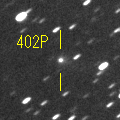
|
It brightened up to 15.3 mag in last winter (Jan. 12, 2022, Hidenori Nohara). Now it is 17.3 mag (Apr. 25, ATLAS-HKO, Haleakala). It stays 18 mag for a while. In the Northern Hemisphere, it will be getting lower gradually. It locates somewhat low in the Southern Hemisphere.
Date(TT) R.A. (2000) Decl. Delta r Elong. m1 Best Time(A, h)
May 6 9 53.98 30 53.3 4.633 4.823 94 17.9 20:24 ( 83, 72)
May 13 9 56.46 30 37.1 4.756 4.843 88 18.0 20:32 ( 88, 65)
|
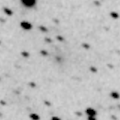
|
Now it is 17.4 mag (Apr. 27, Ken-ichi Kadota). Fading slowly. It will be fainter than 18 mag soon. In the Northern Hemisphere, it stays observable in good condition.
Date(TT) R.A. (2000) Decl. Delta r Elong. m1 Best Time(A, h)
May 6 21 56.75 10 49.7 2.293 2.185 71 17.9 3:30 (283, 36)
May 13 22 3.92 13 7.9 2.265 2.228 74 18.0 3:21 (283, 40)
|
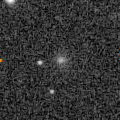
|
It moves along an almost circular orbit. It brightened up to 16.2 mag temporarily in outburst (Jan. 27, Toshihiko Ikemura, Hirohisa Sato). Now it is 17.1 mag (Apr. 25, John Maikner). Fading gradually. It will be fainter than 18 mag soon. In the Northern Hemisphere, it will be getting lower gradually. It locates somewhat low in the Southern Hemisphere.
Date(TT) R.A. (2000) Decl. Delta r Elong. m1 Best Time(A, h)
May 6 10 35.12 25 26.4 5.797 6.141 105 17.9 20:24 ( 47, 76)
May 13 10 35.61 25 6.9 5.901 6.141 99 18.1 20:32 ( 65, 70)
|

|
In its last apparition in 2014, it was re-observed after 36-year blank. It has not been observed yet in this apparition. It will turn to fade out rapidly after brightening. It will be unobservable in July.
Date(TT) R.A. (2000) Decl. Delta r Elong. m1 Best Time(A, h)
May 6 0 0.77 -8 40.9 1.386 1.045 48 18.7 3:30 (280, 0)
May 13 0 35.03 -4 11.6 1.356 0.974 45 17.9 3:21 (274, -1)
|

|
It was predicted to brighten up to 16 mag in 2023. But actually, it is very faint as 18.1 mag (Mar. 29, ATLAS Chile). It stays 19 mag for a while. In the Northern Hemisphere, it is not observable now. In the Southern Hemisphere, it stays observable in good condition.
Date(TT) R.A. (2000) Decl. Delta r Elong. m1 Best Time(A, h)
May 6 21 1.58 -76 27.7 2.930 3.339 105 18.1 3:30 (350,-24)
May 13 21 6.44 -76 48.2 2.898 3.355 108 18.1 3:21 (351,-24)
|
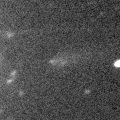
|
Now it is 19.2 mag (Apr. 13, A. Diepvens). Fading slowly. In the Northern Hemisphere, it will be getting lower gradually. In the Southern Hemisphere, it stays observable in good condition. Francois Kugel reported it seems fragmented.
Date(TT) R.A. (2000) Decl. Delta r Elong. m1 Best Time(A, h)
May 6 10 8.46 16 7.0 3.827 4.179 103 18.7 20:24 ( 44, 65)
May 13 10 11.01 15 51.7 3.928 4.179 97 18.8 20:32 ( 57, 60)
|
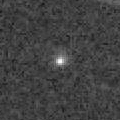
|
It was observed at 17 mag in 2022 autumn. It was predicted to be observable at 17 mag also in 2023 spring. But actually, it is extremely faint as 19.7 mag (Apr. 1, Taras Prystavski). It will fade out rapidly after this. It stays observable in good condition.
Date(TT) R.A. (2000) Decl. Delta r Elong. m1 Best Time(A, h)
May 6 18 42.15 19 38.2 1.428 2.040 112 19.6 3:30 (342, 74)
May 13 18 7.96 22 15.2 1.375 2.092 121 19.7 2:49 ( 0, 77)
|

|
In the last apparition, it had faded before the perihelion passage. It was expected to brighten up to 17 mag if it would become as bright as its last apparition. But actually, it is extremely faint as 22 mag (Apr. 8, Giuseppe Pappa). It stays 22 mag for a while. It stays observable in good condition.
Date(TT) R.A. (2000) Decl. Delta r Elong. m1 Best Time(A, h)
May 6 13 53.67 7 28.1 1.777 2.711 152 21.6 22:57 ( 0, 62)
May 13 13 50.28 7 33.7 1.800 2.701 146 21.6 22:27 ( 0, 62)
|
|
![]()
 199P/Shoemaker 4
199P/Shoemaker 4 C/2020 S4 ( PanSTARRS )
C/2020 S4 ( PanSTARRS ) 185P/Petriew
185P/Petriew C/2022 L2 ( ATLAS )
C/2022 L2 ( ATLAS ) C/2022 E2 ( ATLAS )
C/2022 E2 ( ATLAS ) C/2021 G2 ( ATLAS )
C/2021 G2 ( ATLAS ) C/2023 B2 ( ATLAS )
C/2023 B2 ( ATLAS ) C/2022 W3 ( Leonard )
C/2022 W3 ( Leonard ) C/2020 R7 ( ATLAS )
C/2020 R7 ( ATLAS ) 117P/Helin-Roman-Alu 1
117P/Helin-Roman-Alu 1 C/2022 P1 ( NEOWISE )
C/2022 P1 ( NEOWISE ) 118P/Shoemaker-Levy 4
118P/Shoemaker-Levy 4 C/2022 A3 ( Lemmon-ATLAS )
C/2022 A3 ( Lemmon-ATLAS ) C/2023 A3 ( Tsuchinshan-ATLAS )
C/2023 A3 ( Tsuchinshan-ATLAS ) 119P/Parker-Hartley
119P/Parker-Hartley 94P/Russell 4
94P/Russell 4 C/2019 E3 ( ATLAS )
C/2019 E3 ( ATLAS ) C/2022 U4 ( Bok )
C/2022 U4 ( Bok ) C/2020 F2 ( ATLAS )
C/2020 F2 ( ATLAS ) C/2018 U1 ( Lemmon )
C/2018 U1 ( Lemmon ) C/2022 JK5 ( PanSTARRS )
C/2022 JK5 ( PanSTARRS ) 116P/Wild 4
116P/Wild 4 12P/Pons-Brooks
12P/Pons-Brooks 96P/Machholz 1
96P/Machholz 1 C/2021 E3 ( ZTF )
C/2021 E3 ( ZTF ) 180P/NEAT
180P/NEAT C/2014 UN271 ( Bernardinelli-Bernstein )
C/2014 UN271 ( Bernardinelli-Bernstein ) C/2022 U2 ( ATLAS )
C/2022 U2 ( ATLAS ) 103P/Hartley 2
103P/Hartley 2 C/2023 A1 ( Leonard )
C/2023 A1 ( Leonard ) 287P/Christensen
287P/Christensen 99P/Kowal 1
99P/Kowal 1 219P/LINEAR
219P/LINEAR C/2019 O3 ( Palomar )
C/2019 O3 ( Palomar ) C/2020 H6 ( ATLAS )
C/2020 H6 ( ATLAS ) 402P/2020 Q3 ( LINEAR )
402P/2020 Q3 ( LINEAR ) 80P/Peters-Hartley
80P/Peters-Hartley P/2023 B1 ( PanSTARRS )
P/2023 B1 ( PanSTARRS ) 72P/Denning-Fujikawa
72P/Denning-Fujikawa C/2021 C5 ( PanSTARRS )
C/2021 C5 ( PanSTARRS ) 452P/2022 B5 ( Sheppard-Jewitt )
452P/2022 B5 ( Sheppard-Jewitt ) C/2022 Q2 ( ATLAS )
C/2022 Q2 ( ATLAS ) 280P/Larsen
280P/Larsen![]()
























































